Macroeconomic Analysis and Investment Recommendation: New Zealand
VerifiedAdded on 2023/01/16
|16
|3905
|22
Report
AI Summary
This report provides a detailed macroeconomic analysis of New Zealand, focusing on the country's suitability for investment, particularly in the agriculture sector. It examines the general business environment, including procedures for starting a business and construction permits. The analysis covers key economic variables such as economic growth, unemployment, average wage rates, inflation, and interest rates. The report highlights New Zealand's economic growth, driven by factors like rising salaries, strong tourism, and low-interest rates. It also addresses challenges such as corporate debt and dependence on foreign investment. The report concludes with a recommendation to invest in New Zealand, emphasizing the strong performance of the agriculture sector. The report uses data from various sources to support its findings, including figures on GDP, import/export trends, and unemployment rates, providing a comprehensive overview of the country's economic landscape.

MACROECONOMICS
2019
2019
Paraphrase This Document
Need a fresh take? Get an instant paraphrase of this document with our AI Paraphraser
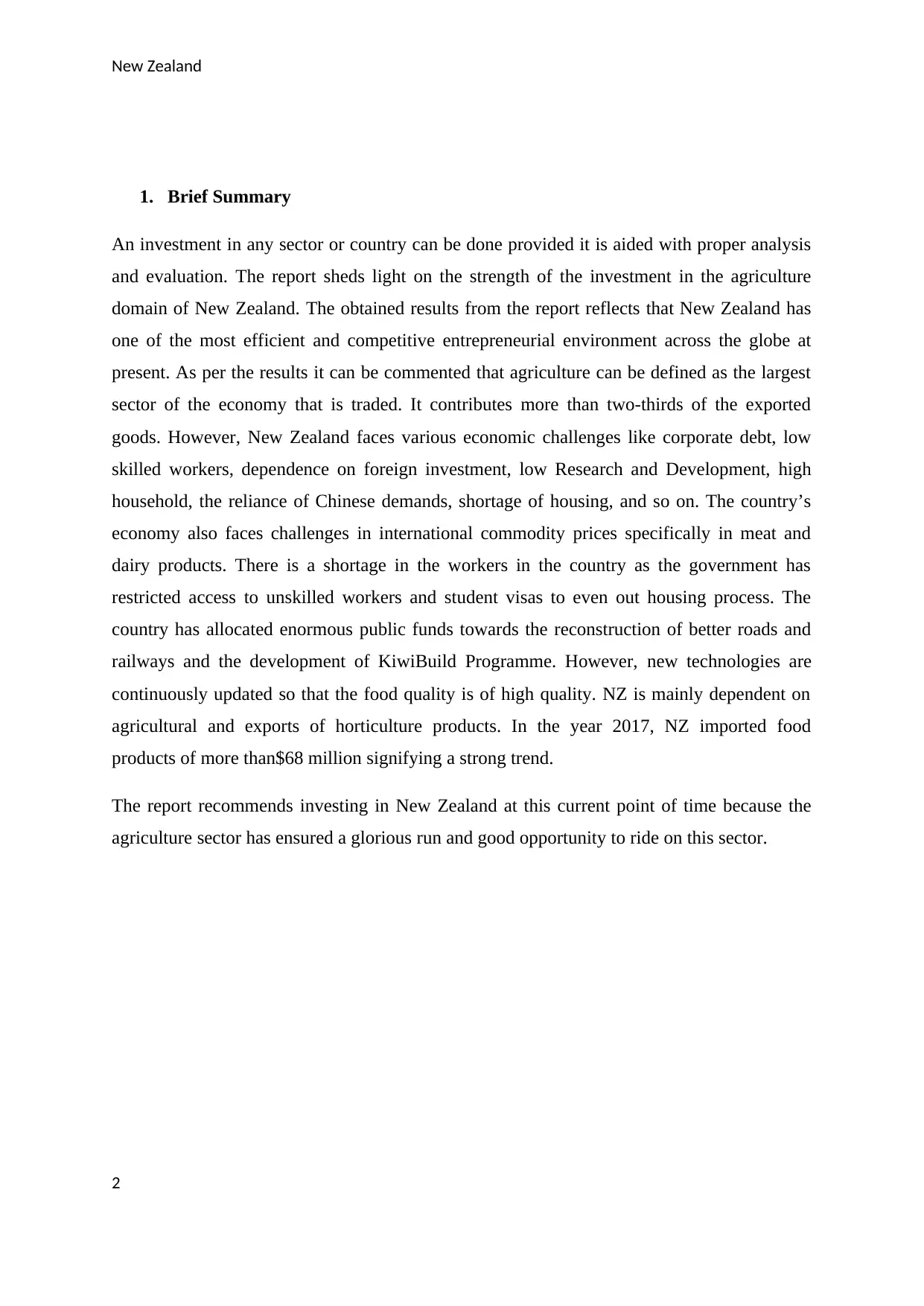
New Zealand
1. Brief Summary
An investment in any sector or country can be done provided it is aided with proper analysis
and evaluation. The report sheds light on the strength of the investment in the agriculture
domain of New Zealand. The obtained results from the report reflects that New Zealand has
one of the most efficient and competitive entrepreneurial environment across the globe at
present. As per the results it can be commented that agriculture can be defined as the largest
sector of the economy that is traded. It contributes more than two-thirds of the exported
goods. However, New Zealand faces various economic challenges like corporate debt, low
skilled workers, dependence on foreign investment, low Research and Development, high
household, the reliance of Chinese demands, shortage of housing, and so on. The country’s
economy also faces challenges in international commodity prices specifically in meat and
dairy products. There is a shortage in the workers in the country as the government has
restricted access to unskilled workers and student visas to even out housing process. The
country has allocated enormous public funds towards the reconstruction of better roads and
railways and the development of KiwiBuild Programme. However, new technologies are
continuously updated so that the food quality is of high quality. NZ is mainly dependent on
agricultural and exports of horticulture products. In the year 2017, NZ imported food
products of more than$68 million signifying a strong trend.
The report recommends investing in New Zealand at this current point of time because the
agriculture sector has ensured a glorious run and good opportunity to ride on this sector.
2
1. Brief Summary
An investment in any sector or country can be done provided it is aided with proper analysis
and evaluation. The report sheds light on the strength of the investment in the agriculture
domain of New Zealand. The obtained results from the report reflects that New Zealand has
one of the most efficient and competitive entrepreneurial environment across the globe at
present. As per the results it can be commented that agriculture can be defined as the largest
sector of the economy that is traded. It contributes more than two-thirds of the exported
goods. However, New Zealand faces various economic challenges like corporate debt, low
skilled workers, dependence on foreign investment, low Research and Development, high
household, the reliance of Chinese demands, shortage of housing, and so on. The country’s
economy also faces challenges in international commodity prices specifically in meat and
dairy products. There is a shortage in the workers in the country as the government has
restricted access to unskilled workers and student visas to even out housing process. The
country has allocated enormous public funds towards the reconstruction of better roads and
railways and the development of KiwiBuild Programme. However, new technologies are
continuously updated so that the food quality is of high quality. NZ is mainly dependent on
agricultural and exports of horticulture products. In the year 2017, NZ imported food
products of more than$68 million signifying a strong trend.
The report recommends investing in New Zealand at this current point of time because the
agriculture sector has ensured a glorious run and good opportunity to ride on this sector.
2
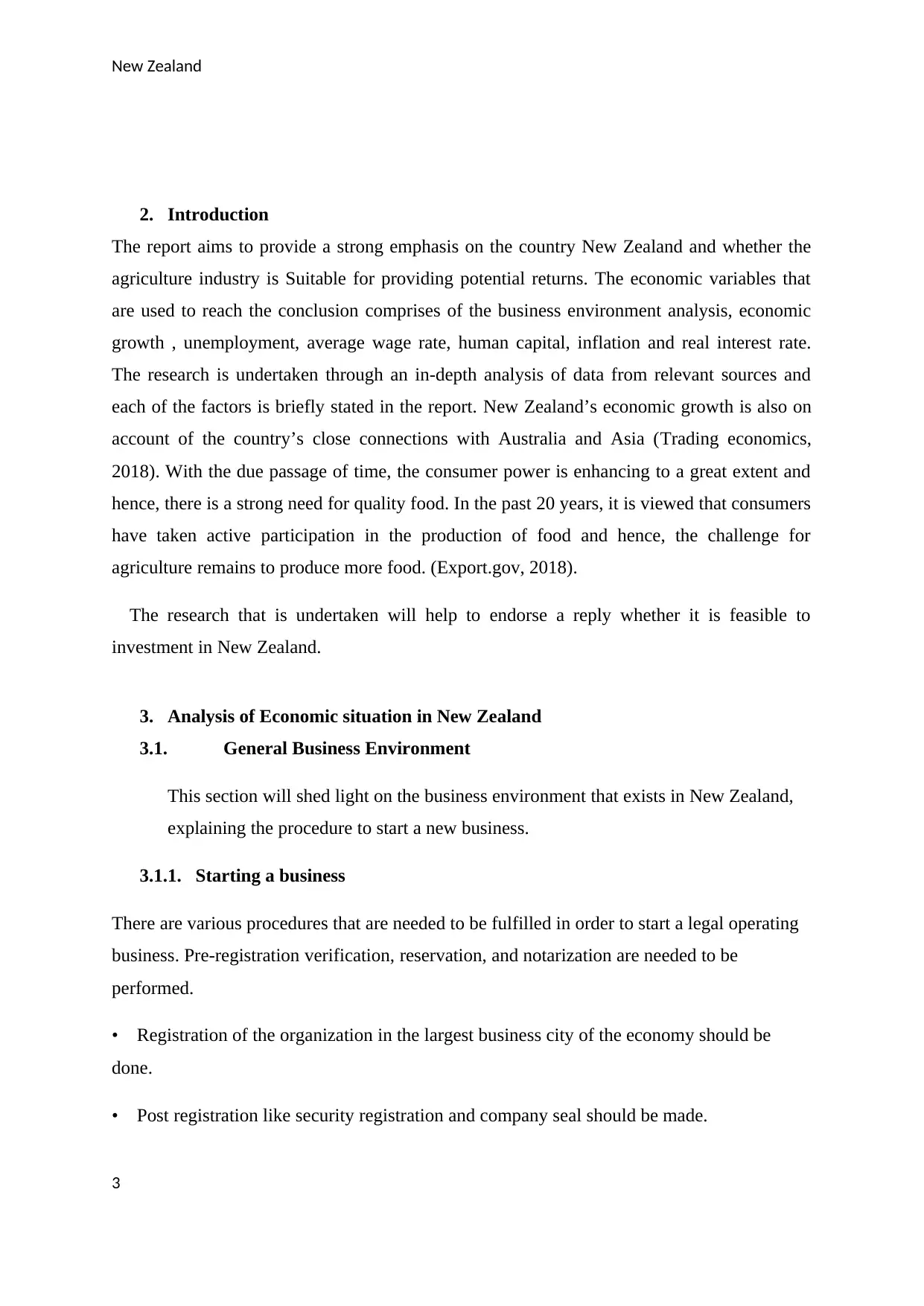
New Zealand
2. Introduction
The report aims to provide a strong emphasis on the country New Zealand and whether the
agriculture industry is Suitable for providing potential returns. The economic variables that
are used to reach the conclusion comprises of the business environment analysis, economic
growth , unemployment, average wage rate, human capital, inflation and real interest rate.
The research is undertaken through an in-depth analysis of data from relevant sources and
each of the factors is briefly stated in the report. New Zealand’s economic growth is also on
account of the country’s close connections with Australia and Asia (Trading economics,
2018). With the due passage of time, the consumer power is enhancing to a great extent and
hence, there is a strong need for quality food. In the past 20 years, it is viewed that consumers
have taken active participation in the production of food and hence, the challenge for
agriculture remains to produce more food. (Export.gov, 2018).
The research that is undertaken will help to endorse a reply whether it is feasible to
investment in New Zealand.
3. Analysis of Economic situation in New Zealand
3.1. General Business Environment
This section will shed light on the business environment that exists in New Zealand,
explaining the procedure to start a new business.
3.1.1. Starting a business
There are various procedures that are needed to be fulfilled in order to start a legal operating
business. Pre-registration verification, reservation, and notarization are needed to be
performed.
• Registration of the organization in the largest business city of the economy should be
done.
• Post registration like security registration and company seal should be made.
3
2. Introduction
The report aims to provide a strong emphasis on the country New Zealand and whether the
agriculture industry is Suitable for providing potential returns. The economic variables that
are used to reach the conclusion comprises of the business environment analysis, economic
growth , unemployment, average wage rate, human capital, inflation and real interest rate.
The research is undertaken through an in-depth analysis of data from relevant sources and
each of the factors is briefly stated in the report. New Zealand’s economic growth is also on
account of the country’s close connections with Australia and Asia (Trading economics,
2018). With the due passage of time, the consumer power is enhancing to a great extent and
hence, there is a strong need for quality food. In the past 20 years, it is viewed that consumers
have taken active participation in the production of food and hence, the challenge for
agriculture remains to produce more food. (Export.gov, 2018).
The research that is undertaken will help to endorse a reply whether it is feasible to
investment in New Zealand.
3. Analysis of Economic situation in New Zealand
3.1. General Business Environment
This section will shed light on the business environment that exists in New Zealand,
explaining the procedure to start a new business.
3.1.1. Starting a business
There are various procedures that are needed to be fulfilled in order to start a legal operating
business. Pre-registration verification, reservation, and notarization are needed to be
performed.
• Registration of the organization in the largest business city of the economy should be
done.
• Post registration like security registration and company seal should be made.
3
⊘ This is a preview!⊘
Do you want full access?
Subscribe today to unlock all pages.

Trusted by 1+ million students worldwide
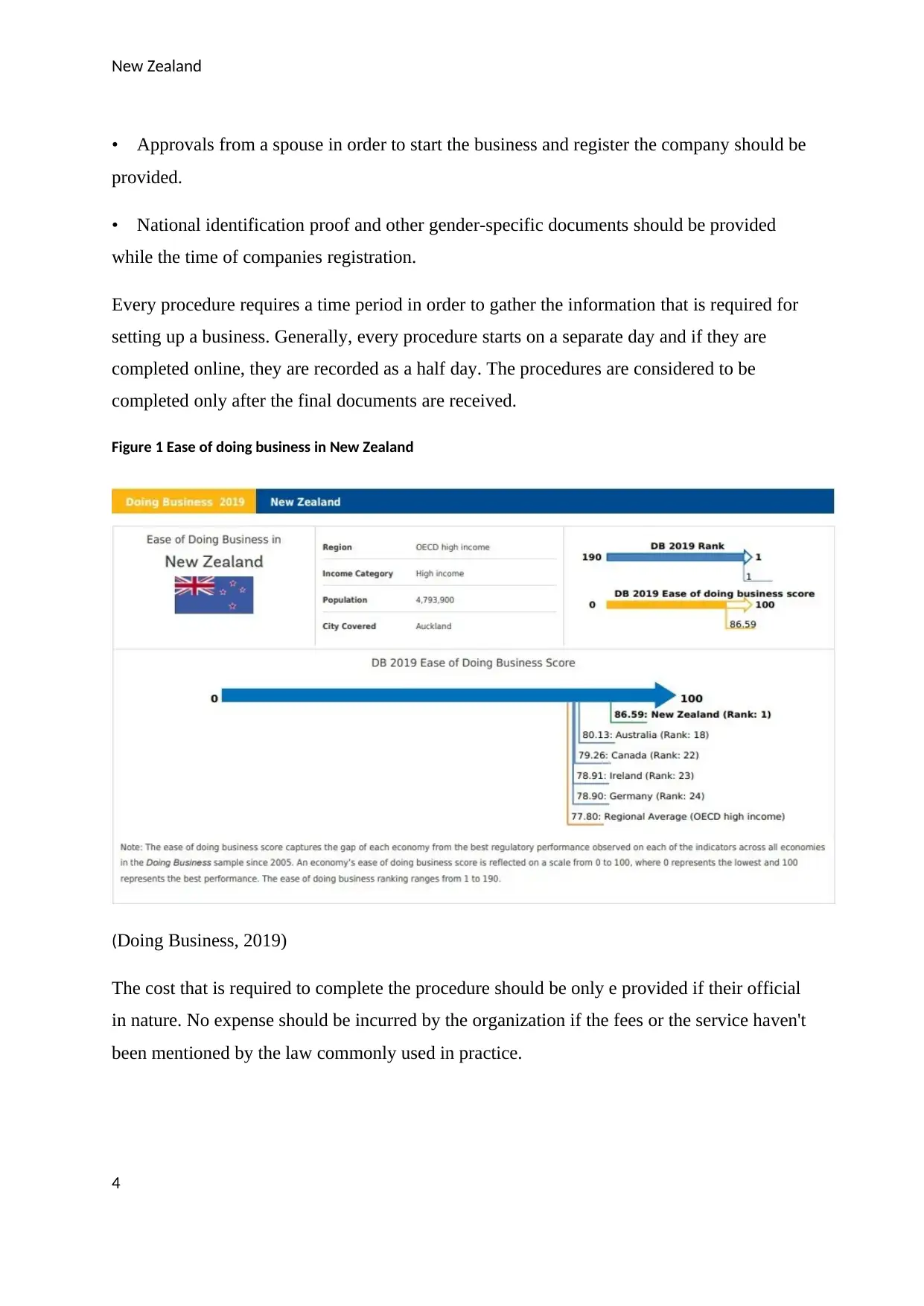
New Zealand
• Approvals from a spouse in order to start the business and register the company should be
provided.
• National identification proof and other gender-specific documents should be provided
while the time of companies registration.
Every procedure requires a time period in order to gather the information that is required for
setting up a business. Generally, every procedure starts on a separate day and if they are
completed online, they are recorded as a half day. The procedures are considered to be
completed only after the final documents are received.
Figure 1 Ease of doing business in New Zealand
(Doing Business, 2019)
The cost that is required to complete the procedure should be only e provided if their official
in nature. No expense should be incurred by the organization if the fees or the service haven't
been mentioned by the law commonly used in practice.
4
• Approvals from a spouse in order to start the business and register the company should be
provided.
• National identification proof and other gender-specific documents should be provided
while the time of companies registration.
Every procedure requires a time period in order to gather the information that is required for
setting up a business. Generally, every procedure starts on a separate day and if they are
completed online, they are recorded as a half day. The procedures are considered to be
completed only after the final documents are received.
Figure 1 Ease of doing business in New Zealand
(Doing Business, 2019)
The cost that is required to complete the procedure should be only e provided if their official
in nature. No expense should be incurred by the organization if the fees or the service haven't
been mentioned by the law commonly used in practice.
4
Paraphrase This Document
Need a fresh take? Get an instant paraphrase of this document with our AI Paraphraser
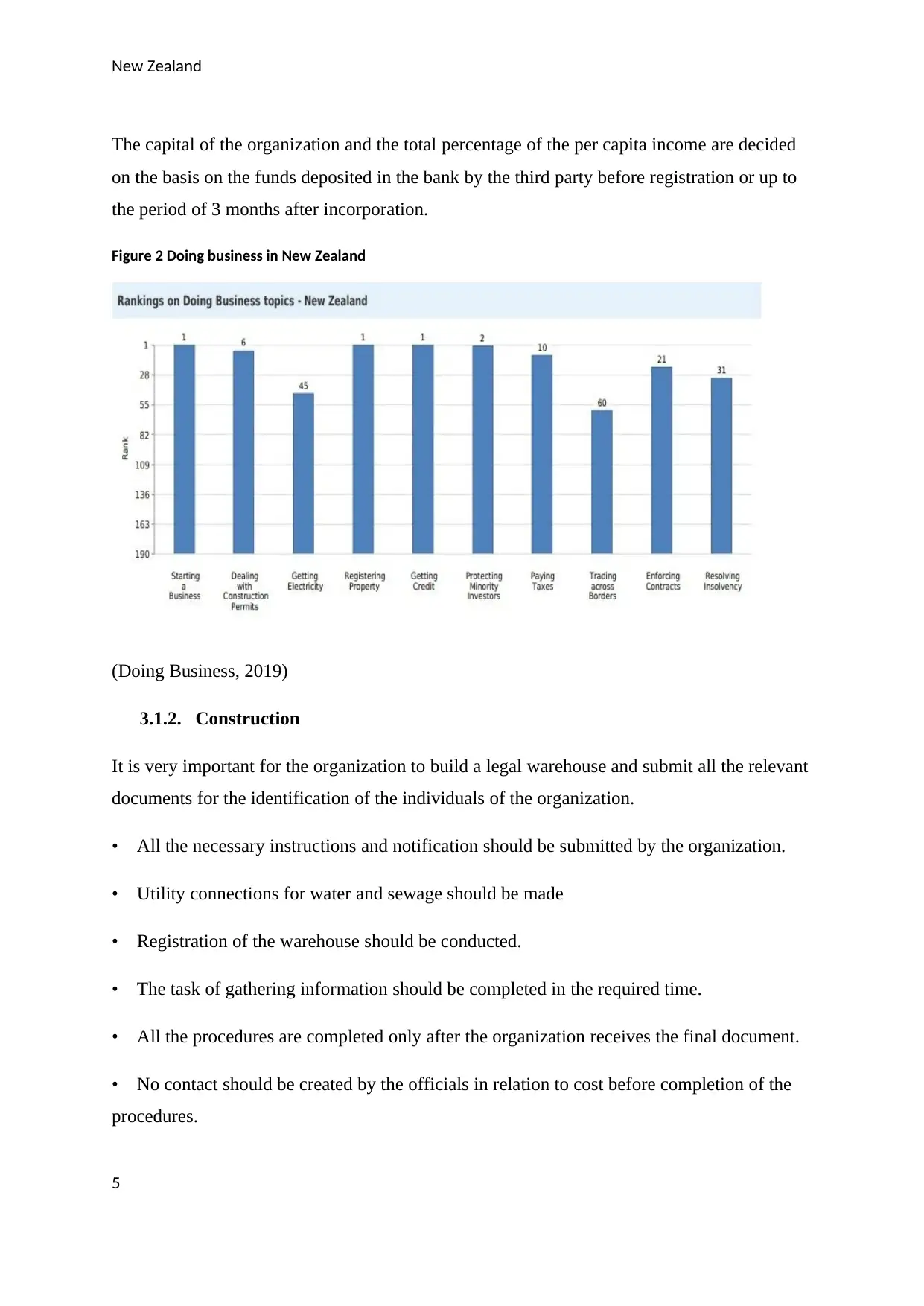
New Zealand
The capital of the organization and the total percentage of the per capita income are decided
on the basis on the funds deposited in the bank by the third party before registration or up to
the period of 3 months after incorporation.
Figure 2 Doing business in New Zealand
(Doing Business, 2019)
3.1.2. Construction
It is very important for the organization to build a legal warehouse and submit all the relevant
documents for the identification of the individuals of the organization.
• All the necessary instructions and notification should be submitted by the organization.
• Utility connections for water and sewage should be made
• Registration of the warehouse should be conducted.
• The task of gathering information should be completed in the required time.
• All the procedures are completed only after the organization receives the final document.
• No contact should be created by the officials in relation to cost before completion of the
procedures.
5
The capital of the organization and the total percentage of the per capita income are decided
on the basis on the funds deposited in the bank by the third party before registration or up to
the period of 3 months after incorporation.
Figure 2 Doing business in New Zealand
(Doing Business, 2019)
3.1.2. Construction
It is very important for the organization to build a legal warehouse and submit all the relevant
documents for the identification of the individuals of the organization.
• All the necessary instructions and notification should be submitted by the organization.
• Utility connections for water and sewage should be made
• Registration of the warehouse should be conducted.
• The task of gathering information should be completed in the required time.
• All the procedures are completed only after the organization receives the final document.
• No contact should be created by the officials in relation to cost before completion of the
procedures.
5
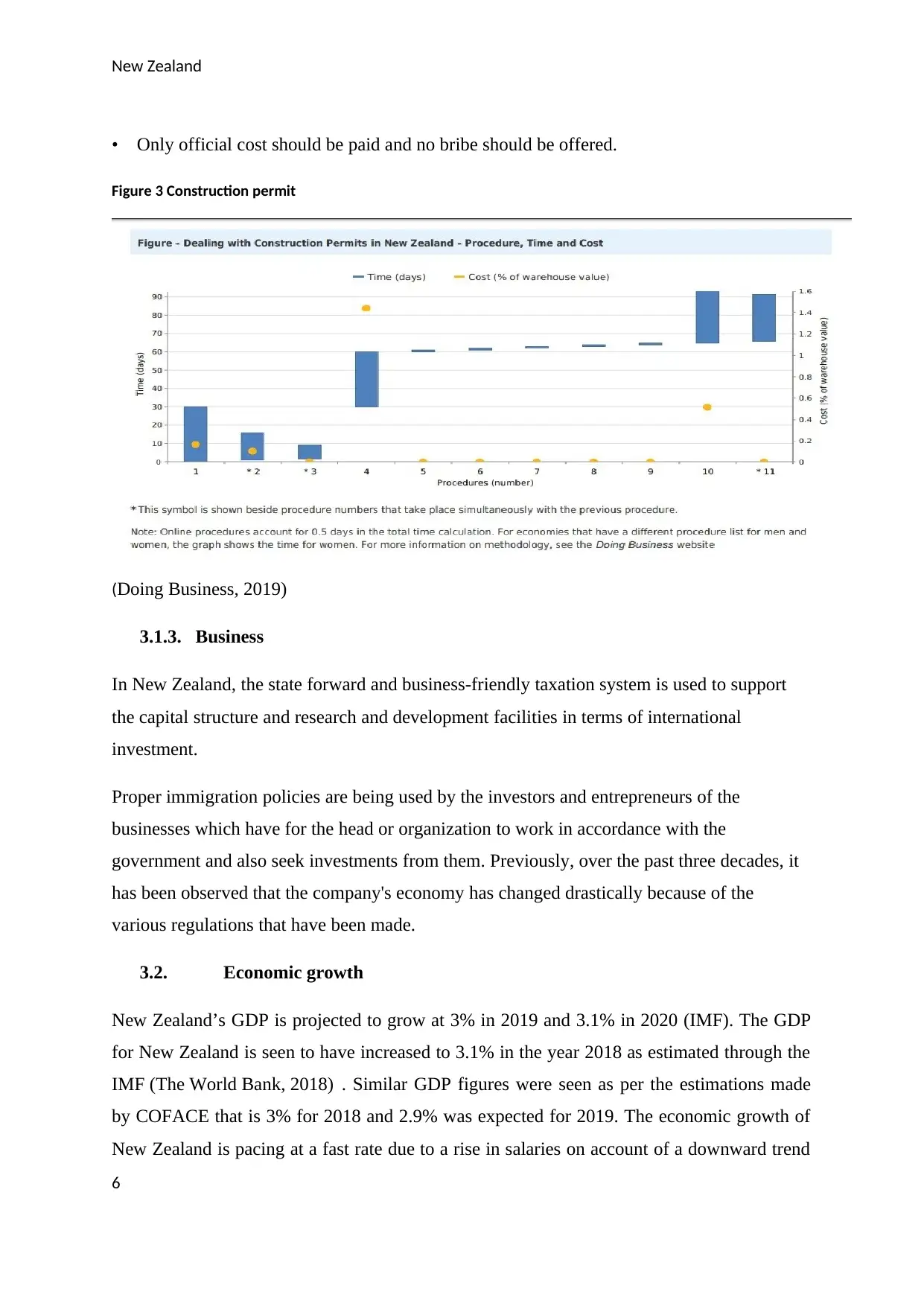
New Zealand
• Only official cost should be paid and no bribe should be offered.
Figure 3 Construction permit
(Doing Business, 2019)
3.1.3. Business
In New Zealand, the state forward and business-friendly taxation system is used to support
the capital structure and research and development facilities in terms of international
investment.
Proper immigration policies are being used by the investors and entrepreneurs of the
businesses which have for the head or organization to work in accordance with the
government and also seek investments from them. Previously, over the past three decades, it
has been observed that the company's economy has changed drastically because of the
various regulations that have been made.
3.2. Economic growth
New Zealand’s GDP is projected to grow at 3% in 2019 and 3.1% in 2020 (IMF). The GDP
for New Zealand is seen to have increased to 3.1% in the year 2018 as estimated through the
IMF (The World Bank, 2018) . Similar GDP figures were seen as per the estimations made
by COFACE that is 3% for 2018 and 2.9% was expected for 2019. The economic growth of
New Zealand is pacing at a fast rate due to a rise in salaries on account of a downward trend
6
• Only official cost should be paid and no bribe should be offered.
Figure 3 Construction permit
(Doing Business, 2019)
3.1.3. Business
In New Zealand, the state forward and business-friendly taxation system is used to support
the capital structure and research and development facilities in terms of international
investment.
Proper immigration policies are being used by the investors and entrepreneurs of the
businesses which have for the head or organization to work in accordance with the
government and also seek investments from them. Previously, over the past three decades, it
has been observed that the company's economy has changed drastically because of the
various regulations that have been made.
3.2. Economic growth
New Zealand’s GDP is projected to grow at 3% in 2019 and 3.1% in 2020 (IMF). The GDP
for New Zealand is seen to have increased to 3.1% in the year 2018 as estimated through the
IMF (The World Bank, 2018) . Similar GDP figures were seen as per the estimations made
by COFACE that is 3% for 2018 and 2.9% was expected for 2019. The economic growth of
New Zealand is pacing at a fast rate due to a rise in salaries on account of a downward trend
6
⊘ This is a preview!⊘
Do you want full access?
Subscribe today to unlock all pages.

Trusted by 1+ million students worldwide
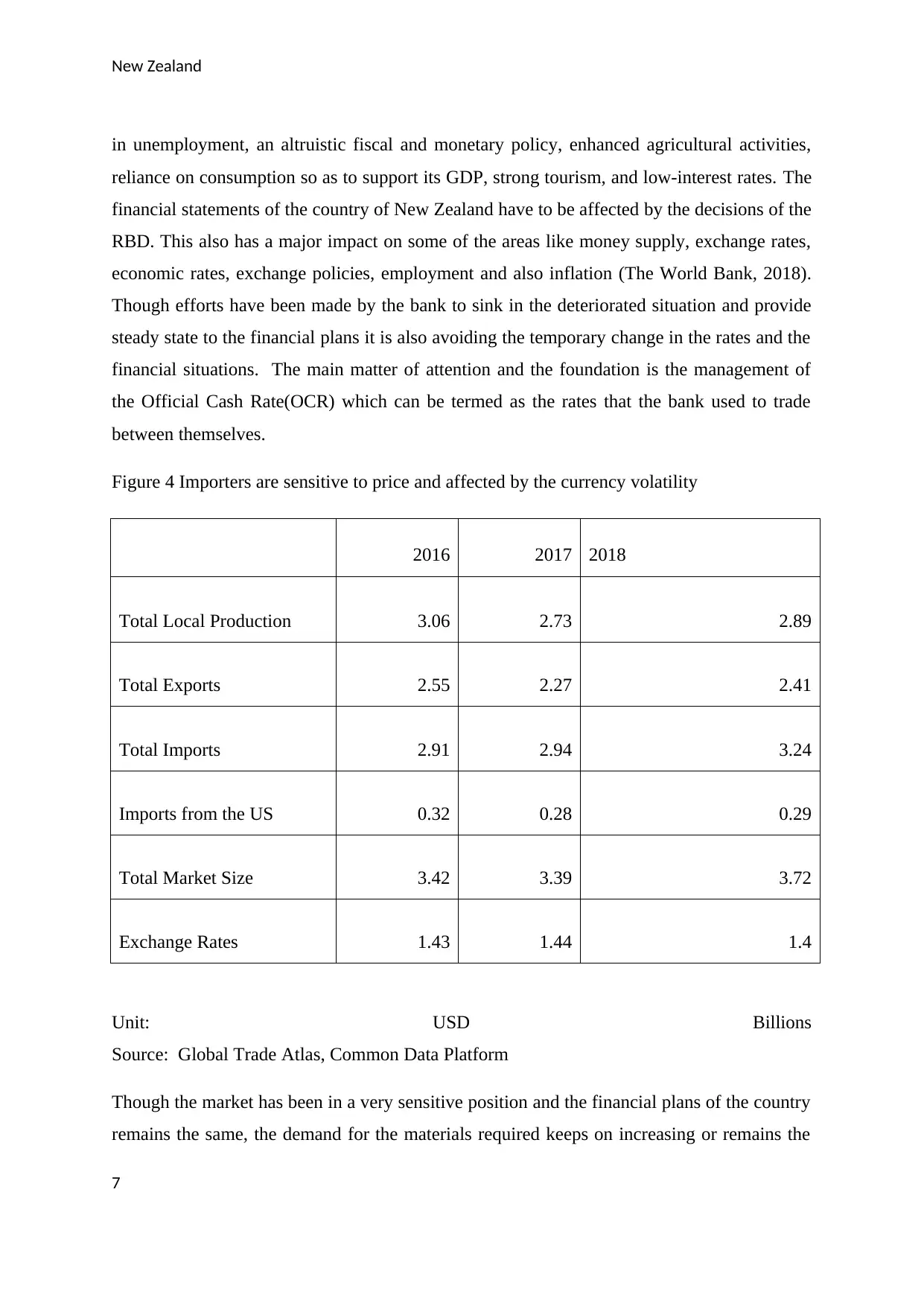
New Zealand
in unemployment, an altruistic fiscal and monetary policy, enhanced agricultural activities,
reliance on consumption so as to support its GDP, strong tourism, and low-interest rates. The
financial statements of the country of New Zealand have to be affected by the decisions of the
RBD. This also has a major impact on some of the areas like money supply, exchange rates,
economic rates, exchange policies, employment and also inflation (The World Bank, 2018).
Though efforts have been made by the bank to sink in the deteriorated situation and provide
steady state to the financial plans it is also avoiding the temporary change in the rates and the
financial situations. The main matter of attention and the foundation is the management of
the Official Cash Rate(OCR) which can be termed as the rates that the bank used to trade
between themselves.
Figure 4 Importers are sensitive to price and affected by the currency volatility
2016 2017 2018
Total Local Production 3.06 2.73 2.89
Total Exports 2.55 2.27 2.41
Total Imports 2.91 2.94 3.24
Imports from the US 0.32 0.28 0.29
Total Market Size 3.42 3.39 3.72
Exchange Rates 1.43 1.44 1.4
Unit: USD Billions
Source: Global Trade Atlas, Common Data Platform
Though the market has been in a very sensitive position and the financial plans of the country
remains the same, the demand for the materials required keeps on increasing or remains the
7
in unemployment, an altruistic fiscal and monetary policy, enhanced agricultural activities,
reliance on consumption so as to support its GDP, strong tourism, and low-interest rates. The
financial statements of the country of New Zealand have to be affected by the decisions of the
RBD. This also has a major impact on some of the areas like money supply, exchange rates,
economic rates, exchange policies, employment and also inflation (The World Bank, 2018).
Though efforts have been made by the bank to sink in the deteriorated situation and provide
steady state to the financial plans it is also avoiding the temporary change in the rates and the
financial situations. The main matter of attention and the foundation is the management of
the Official Cash Rate(OCR) which can be termed as the rates that the bank used to trade
between themselves.
Figure 4 Importers are sensitive to price and affected by the currency volatility
2016 2017 2018
Total Local Production 3.06 2.73 2.89
Total Exports 2.55 2.27 2.41
Total Imports 2.91 2.94 3.24
Imports from the US 0.32 0.28 0.29
Total Market Size 3.42 3.39 3.72
Exchange Rates 1.43 1.44 1.4
Unit: USD Billions
Source: Global Trade Atlas, Common Data Platform
Though the market has been in a very sensitive position and the financial plans of the country
remains the same, the demand for the materials required keeps on increasing or remains the
7
Paraphrase This Document
Need a fresh take? Get an instant paraphrase of this document with our AI Paraphraser

New Zealand
same on a daily basis and this has put up some weight on the country of New Zealand
compared to the other major players in the market. The bank of the country has the option to
reduce the nominal interests in welfare consideration as the inflation condition has also seen
to increase the price of oil as in from 2008 and this can assure and support the fact that the
bank of the country of New Zealand has reduced the OCR by 575 points in the estimated time
of June 20018 and June 2009. Thus it can be said that the financial plans were the supporting
pillars in a very crucial time (Trading economics, 2018). Though the time was sensitive then
also the interest rates were stable and even dropped in terms of the domestic scenario. All the
situations pertaining to the inflation terms caused a stir which was seen that the executing
interest rate were the ones which were once considered as negligible (Morrison, 2019). This
resulted in a picture of the financial plans as a core strength and this was assured by the terms
that the technique in the banking management was much more efficient than in the other
economies.
A helping hand from the government has been promised to be seen soon enough. Although
the case suggests that the rise in the GDP is on a temporary basis and the selling of the
materials are of little foundations which will keep decreasing as the time increases. It can be
assumed that the weather changes will have a positive impact on the sales which will be slow
but steady in nature and for the imports it can be said that the demand ratio is higher which
has kept the rate cards of the imports up (Blanchard & Leigh, 2013). Business, as well as the
plant increment, can be expected in the upcoming times but the basis seems to be a little weak
for this still.
Figure 5 Economic growth
8
same on a daily basis and this has put up some weight on the country of New Zealand
compared to the other major players in the market. The bank of the country has the option to
reduce the nominal interests in welfare consideration as the inflation condition has also seen
to increase the price of oil as in from 2008 and this can assure and support the fact that the
bank of the country of New Zealand has reduced the OCR by 575 points in the estimated time
of June 20018 and June 2009. Thus it can be said that the financial plans were the supporting
pillars in a very crucial time (Trading economics, 2018). Though the time was sensitive then
also the interest rates were stable and even dropped in terms of the domestic scenario. All the
situations pertaining to the inflation terms caused a stir which was seen that the executing
interest rate were the ones which were once considered as negligible (Morrison, 2019). This
resulted in a picture of the financial plans as a core strength and this was assured by the terms
that the technique in the banking management was much more efficient than in the other
economies.
A helping hand from the government has been promised to be seen soon enough. Although
the case suggests that the rise in the GDP is on a temporary basis and the selling of the
materials are of little foundations which will keep decreasing as the time increases. It can be
assumed that the weather changes will have a positive impact on the sales which will be slow
but steady in nature and for the imports it can be said that the demand ratio is higher which
has kept the rate cards of the imports up (Blanchard & Leigh, 2013). Business, as well as the
plant increment, can be expected in the upcoming times but the basis seems to be a little weak
for this still.
Figure 5 Economic growth
8
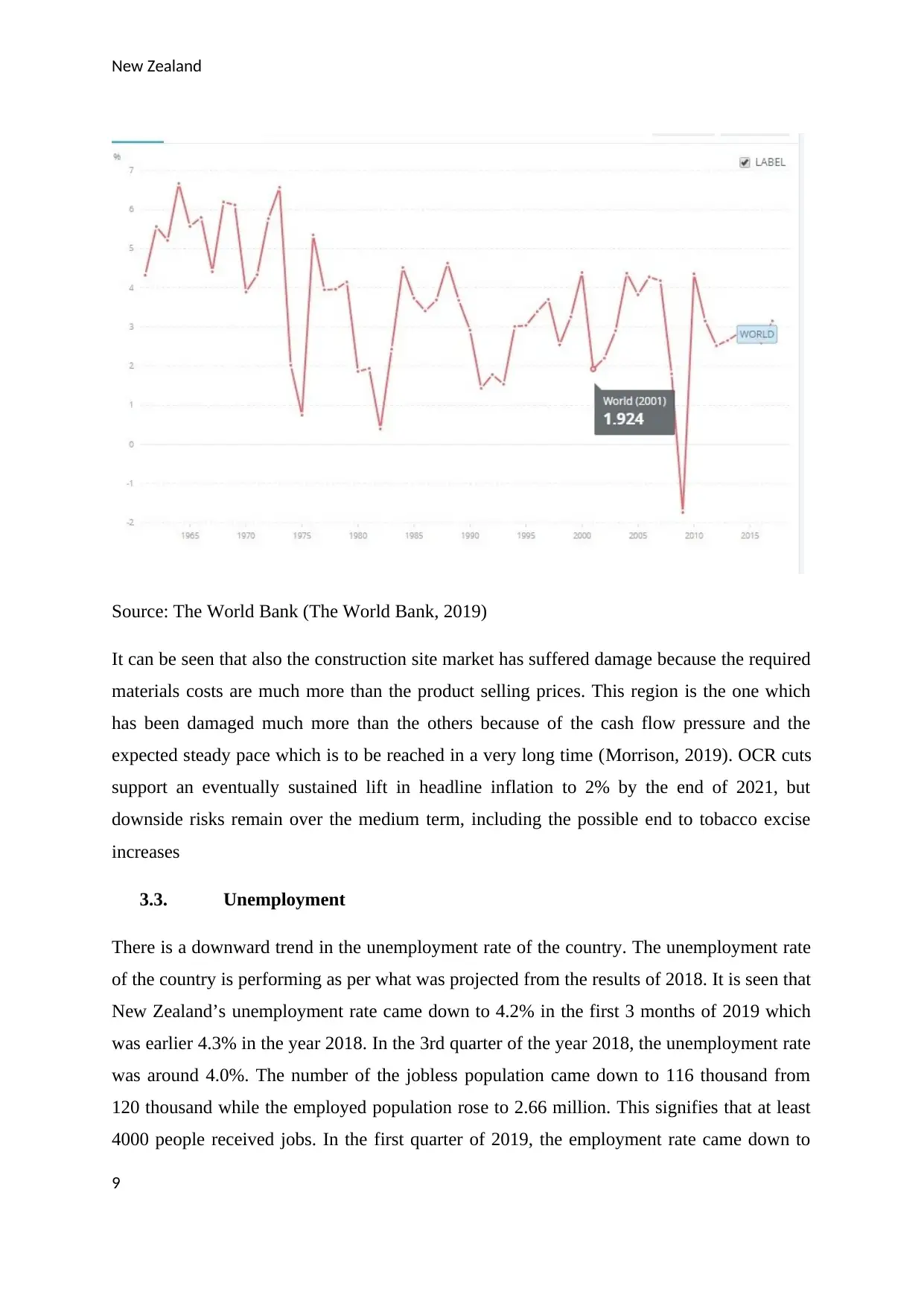
New Zealand
Source: The World Bank (The World Bank, 2019)
It can be seen that also the construction site market has suffered damage because the required
materials costs are much more than the product selling prices. This region is the one which
has been damaged much more than the others because of the cash flow pressure and the
expected steady pace which is to be reached in a very long time (Morrison, 2019). OCR cuts
support an eventually sustained lift in headline inflation to 2% by the end of 2021, but
downside risks remain over the medium term, including the possible end to tobacco excise
increases
3.3. Unemployment
There is a downward trend in the unemployment rate of the country. The unemployment rate
of the country is performing as per what was projected from the results of 2018. It is seen that
New Zealand’s unemployment rate came down to 4.2% in the first 3 months of 2019 which
was earlier 4.3% in the year 2018. In the 3rd quarter of the year 2018, the unemployment rate
was around 4.0%. The number of the jobless population came down to 116 thousand from
120 thousand while the employed population rose to 2.66 million. This signifies that at least
4000 people received jobs. In the first quarter of 2019, the employment rate came down to
9
Source: The World Bank (The World Bank, 2019)
It can be seen that also the construction site market has suffered damage because the required
materials costs are much more than the product selling prices. This region is the one which
has been damaged much more than the others because of the cash flow pressure and the
expected steady pace which is to be reached in a very long time (Morrison, 2019). OCR cuts
support an eventually sustained lift in headline inflation to 2% by the end of 2021, but
downside risks remain over the medium term, including the possible end to tobacco excise
increases
3.3. Unemployment
There is a downward trend in the unemployment rate of the country. The unemployment rate
of the country is performing as per what was projected from the results of 2018. It is seen that
New Zealand’s unemployment rate came down to 4.2% in the first 3 months of 2019 which
was earlier 4.3% in the year 2018. In the 3rd quarter of the year 2018, the unemployment rate
was around 4.0%. The number of the jobless population came down to 116 thousand from
120 thousand while the employed population rose to 2.66 million. This signifies that at least
4000 people received jobs. In the first quarter of 2019, the employment rate came down to
9
⊘ This is a preview!⊘
Do you want full access?
Subscribe today to unlock all pages.

Trusted by 1+ million students worldwide
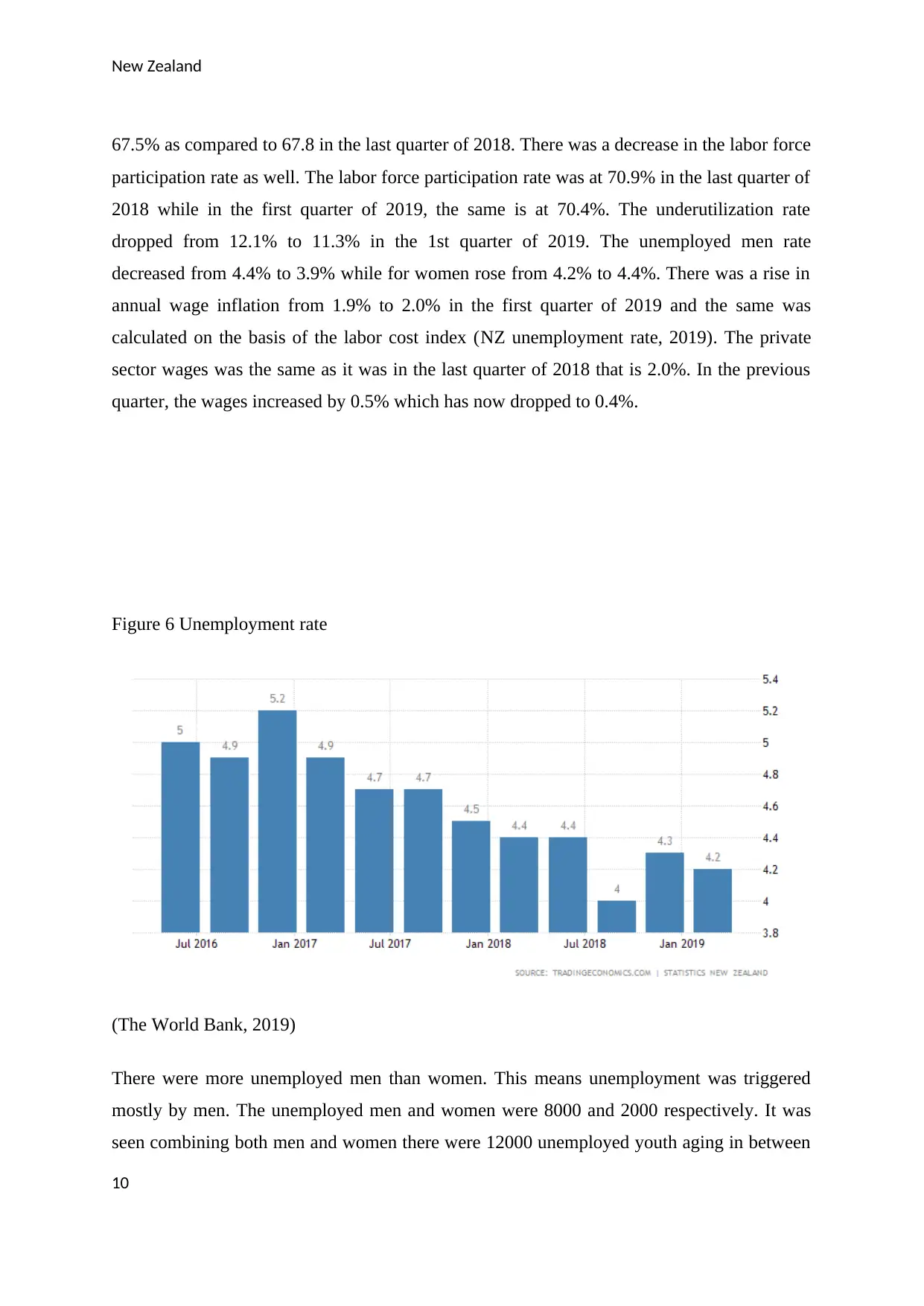
New Zealand
67.5% as compared to 67.8 in the last quarter of 2018. There was a decrease in the labor force
participation rate as well. The labor force participation rate was at 70.9% in the last quarter of
2018 while in the first quarter of 2019, the same is at 70.4%. The underutilization rate
dropped from 12.1% to 11.3% in the 1st quarter of 2019. The unemployed men rate
decreased from 4.4% to 3.9% while for women rose from 4.2% to 4.4%. There was a rise in
annual wage inflation from 1.9% to 2.0% in the first quarter of 2019 and the same was
calculated on the basis of the labor cost index (NZ unemployment rate, 2019). The private
sector wages was the same as it was in the last quarter of 2018 that is 2.0%. In the previous
quarter, the wages increased by 0.5% which has now dropped to 0.4%.
Figure 6 Unemployment rate
(The World Bank, 2019)
There were more unemployed men than women. This means unemployment was triggered
mostly by men. The unemployed men and women were 8000 and 2000 respectively. It was
seen combining both men and women there were 12000 unemployed youth aging in between
10
67.5% as compared to 67.8 in the last quarter of 2018. There was a decrease in the labor force
participation rate as well. The labor force participation rate was at 70.9% in the last quarter of
2018 while in the first quarter of 2019, the same is at 70.4%. The underutilization rate
dropped from 12.1% to 11.3% in the 1st quarter of 2019. The unemployed men rate
decreased from 4.4% to 3.9% while for women rose from 4.2% to 4.4%. There was a rise in
annual wage inflation from 1.9% to 2.0% in the first quarter of 2019 and the same was
calculated on the basis of the labor cost index (NZ unemployment rate, 2019). The private
sector wages was the same as it was in the last quarter of 2018 that is 2.0%. In the previous
quarter, the wages increased by 0.5% which has now dropped to 0.4%.
Figure 6 Unemployment rate
(The World Bank, 2019)
There were more unemployed men than women. This means unemployment was triggered
mostly by men. The unemployed men and women were 8000 and 2000 respectively. It was
seen combining both men and women there were 12000 unemployed youth aging in between
10
Paraphrase This Document
Need a fresh take? Get an instant paraphrase of this document with our AI Paraphraser
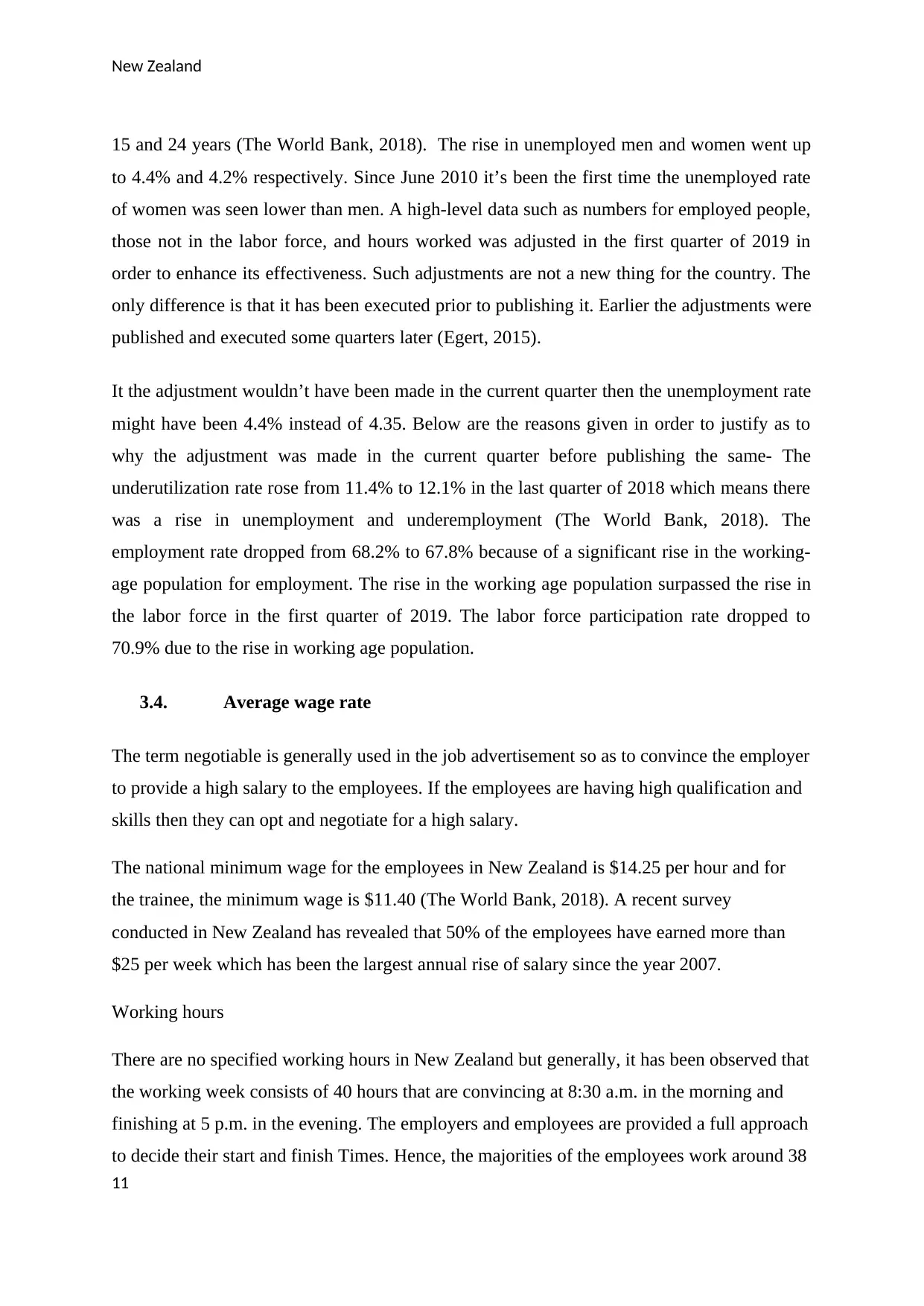
New Zealand
15 and 24 years (The World Bank, 2018). The rise in unemployed men and women went up
to 4.4% and 4.2% respectively. Since June 2010 it’s been the first time the unemployed rate
of women was seen lower than men. A high-level data such as numbers for employed people,
those not in the labor force, and hours worked was adjusted in the first quarter of 2019 in
order to enhance its effectiveness. Such adjustments are not a new thing for the country. The
only difference is that it has been executed prior to publishing it. Earlier the adjustments were
published and executed some quarters later (Egert, 2015).
It the adjustment wouldn’t have been made in the current quarter then the unemployment rate
might have been 4.4% instead of 4.35. Below are the reasons given in order to justify as to
why the adjustment was made in the current quarter before publishing the same- The
underutilization rate rose from 11.4% to 12.1% in the last quarter of 2018 which means there
was a rise in unemployment and underemployment (The World Bank, 2018). The
employment rate dropped from 68.2% to 67.8% because of a significant rise in the working-
age population for employment. The rise in the working age population surpassed the rise in
the labor force in the first quarter of 2019. The labor force participation rate dropped to
70.9% due to the rise in working age population.
3.4. Average wage rate
The term negotiable is generally used in the job advertisement so as to convince the employer
to provide a high salary to the employees. If the employees are having high qualification and
skills then they can opt and negotiate for a high salary.
The national minimum wage for the employees in New Zealand is $14.25 per hour and for
the trainee, the minimum wage is $11.40 (The World Bank, 2018). A recent survey
conducted in New Zealand has revealed that 50% of the employees have earned more than
$25 per week which has been the largest annual rise of salary since the year 2007.
Working hours
There are no specified working hours in New Zealand but generally, it has been observed that
the working week consists of 40 hours that are convincing at 8:30 a.m. in the morning and
finishing at 5 p.m. in the evening. The employers and employees are provided a full approach
to decide their start and finish Times. Hence, the majorities of the employees work around 38
11
15 and 24 years (The World Bank, 2018). The rise in unemployed men and women went up
to 4.4% and 4.2% respectively. Since June 2010 it’s been the first time the unemployed rate
of women was seen lower than men. A high-level data such as numbers for employed people,
those not in the labor force, and hours worked was adjusted in the first quarter of 2019 in
order to enhance its effectiveness. Such adjustments are not a new thing for the country. The
only difference is that it has been executed prior to publishing it. Earlier the adjustments were
published and executed some quarters later (Egert, 2015).
It the adjustment wouldn’t have been made in the current quarter then the unemployment rate
might have been 4.4% instead of 4.35. Below are the reasons given in order to justify as to
why the adjustment was made in the current quarter before publishing the same- The
underutilization rate rose from 11.4% to 12.1% in the last quarter of 2018 which means there
was a rise in unemployment and underemployment (The World Bank, 2018). The
employment rate dropped from 68.2% to 67.8% because of a significant rise in the working-
age population for employment. The rise in the working age population surpassed the rise in
the labor force in the first quarter of 2019. The labor force participation rate dropped to
70.9% due to the rise in working age population.
3.4. Average wage rate
The term negotiable is generally used in the job advertisement so as to convince the employer
to provide a high salary to the employees. If the employees are having high qualification and
skills then they can opt and negotiate for a high salary.
The national minimum wage for the employees in New Zealand is $14.25 per hour and for
the trainee, the minimum wage is $11.40 (The World Bank, 2018). A recent survey
conducted in New Zealand has revealed that 50% of the employees have earned more than
$25 per week which has been the largest annual rise of salary since the year 2007.
Working hours
There are no specified working hours in New Zealand but generally, it has been observed that
the working week consists of 40 hours that are convincing at 8:30 a.m. in the morning and
finishing at 5 p.m. in the evening. The employers and employees are provided a full approach
to decide their start and finish Times. Hence, the majorities of the employees work around 38
11
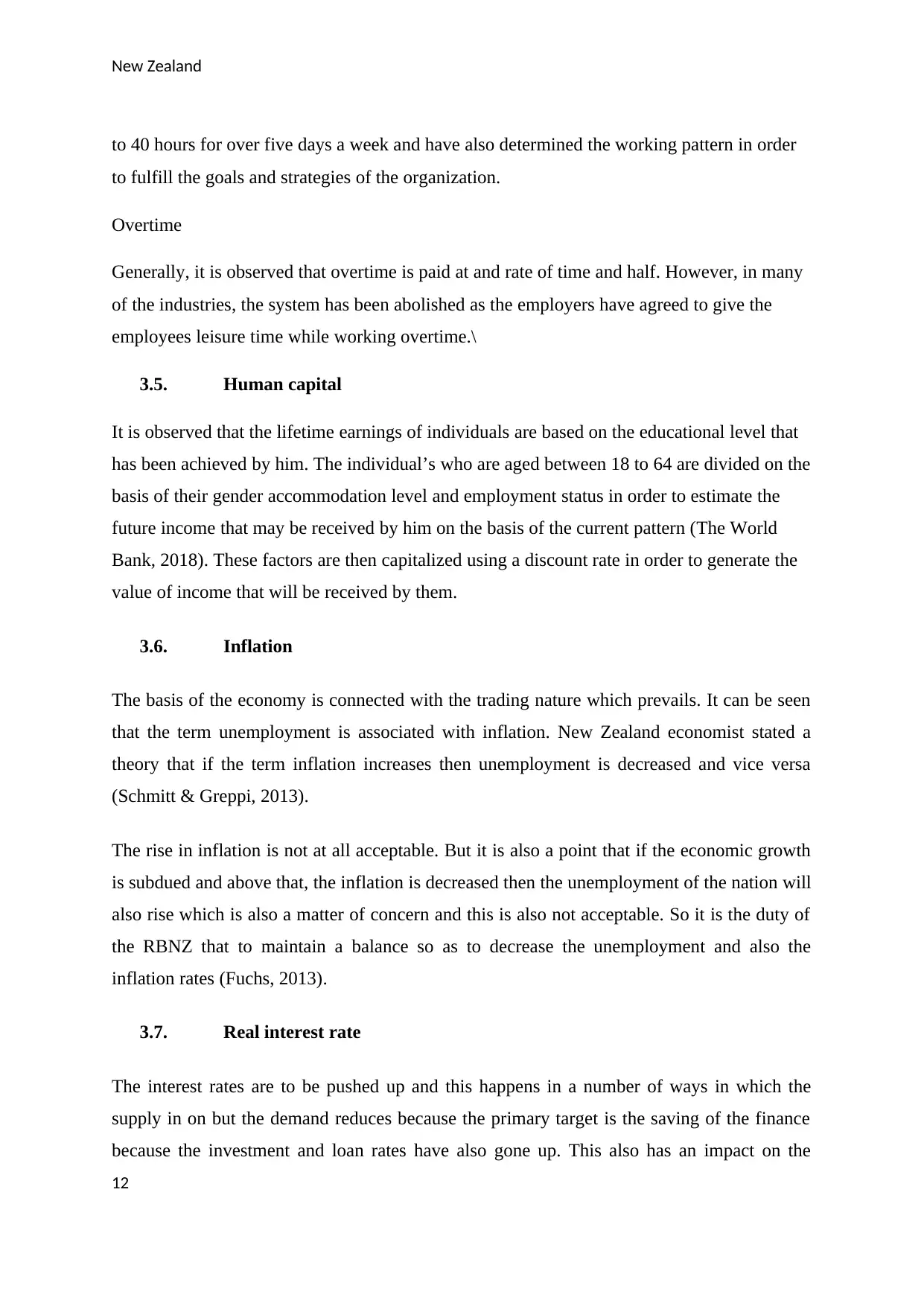
New Zealand
to 40 hours for over five days a week and have also determined the working pattern in order
to fulfill the goals and strategies of the organization.
Overtime
Generally, it is observed that overtime is paid at and rate of time and half. However, in many
of the industries, the system has been abolished as the employers have agreed to give the
employees leisure time while working overtime.\
3.5. Human capital
It is observed that the lifetime earnings of individuals are based on the educational level that
has been achieved by him. The individual’s who are aged between 18 to 64 are divided on the
basis of their gender accommodation level and employment status in order to estimate the
future income that may be received by him on the basis of the current pattern (The World
Bank, 2018). These factors are then capitalized using a discount rate in order to generate the
value of income that will be received by them.
3.6. Inflation
The basis of the economy is connected with the trading nature which prevails. It can be seen
that the term unemployment is associated with inflation. New Zealand economist stated a
theory that if the term inflation increases then unemployment is decreased and vice versa
(Schmitt & Greppi, 2013).
The rise in inflation is not at all acceptable. But it is also a point that if the economic growth
is subdued and above that, the inflation is decreased then the unemployment of the nation will
also rise which is also a matter of concern and this is also not acceptable. So it is the duty of
the RBNZ that to maintain a balance so as to decrease the unemployment and also the
inflation rates (Fuchs, 2013).
3.7. Real interest rate
The interest rates are to be pushed up and this happens in a number of ways in which the
supply in on but the demand reduces because the primary target is the saving of the finance
because the investment and loan rates have also gone up. This also has an impact on the
12
to 40 hours for over five days a week and have also determined the working pattern in order
to fulfill the goals and strategies of the organization.
Overtime
Generally, it is observed that overtime is paid at and rate of time and half. However, in many
of the industries, the system has been abolished as the employers have agreed to give the
employees leisure time while working overtime.\
3.5. Human capital
It is observed that the lifetime earnings of individuals are based on the educational level that
has been achieved by him. The individual’s who are aged between 18 to 64 are divided on the
basis of their gender accommodation level and employment status in order to estimate the
future income that may be received by him on the basis of the current pattern (The World
Bank, 2018). These factors are then capitalized using a discount rate in order to generate the
value of income that will be received by them.
3.6. Inflation
The basis of the economy is connected with the trading nature which prevails. It can be seen
that the term unemployment is associated with inflation. New Zealand economist stated a
theory that if the term inflation increases then unemployment is decreased and vice versa
(Schmitt & Greppi, 2013).
The rise in inflation is not at all acceptable. But it is also a point that if the economic growth
is subdued and above that, the inflation is decreased then the unemployment of the nation will
also rise which is also a matter of concern and this is also not acceptable. So it is the duty of
the RBNZ that to maintain a balance so as to decrease the unemployment and also the
inflation rates (Fuchs, 2013).
3.7. Real interest rate
The interest rates are to be pushed up and this happens in a number of ways in which the
supply in on but the demand reduces because the primary target is the saving of the finance
because the investment and loan rates have also gone up. This also has an impact on the
12
⊘ This is a preview!⊘
Do you want full access?
Subscribe today to unlock all pages.

Trusted by 1+ million students worldwide
1 out of 16
Related Documents
Your All-in-One AI-Powered Toolkit for Academic Success.
+13062052269
info@desklib.com
Available 24*7 on WhatsApp / Email
![[object Object]](/_next/static/media/star-bottom.7253800d.svg)
Unlock your academic potential
Copyright © 2020–2025 A2Z Services. All Rights Reserved. Developed and managed by ZUCOL.





